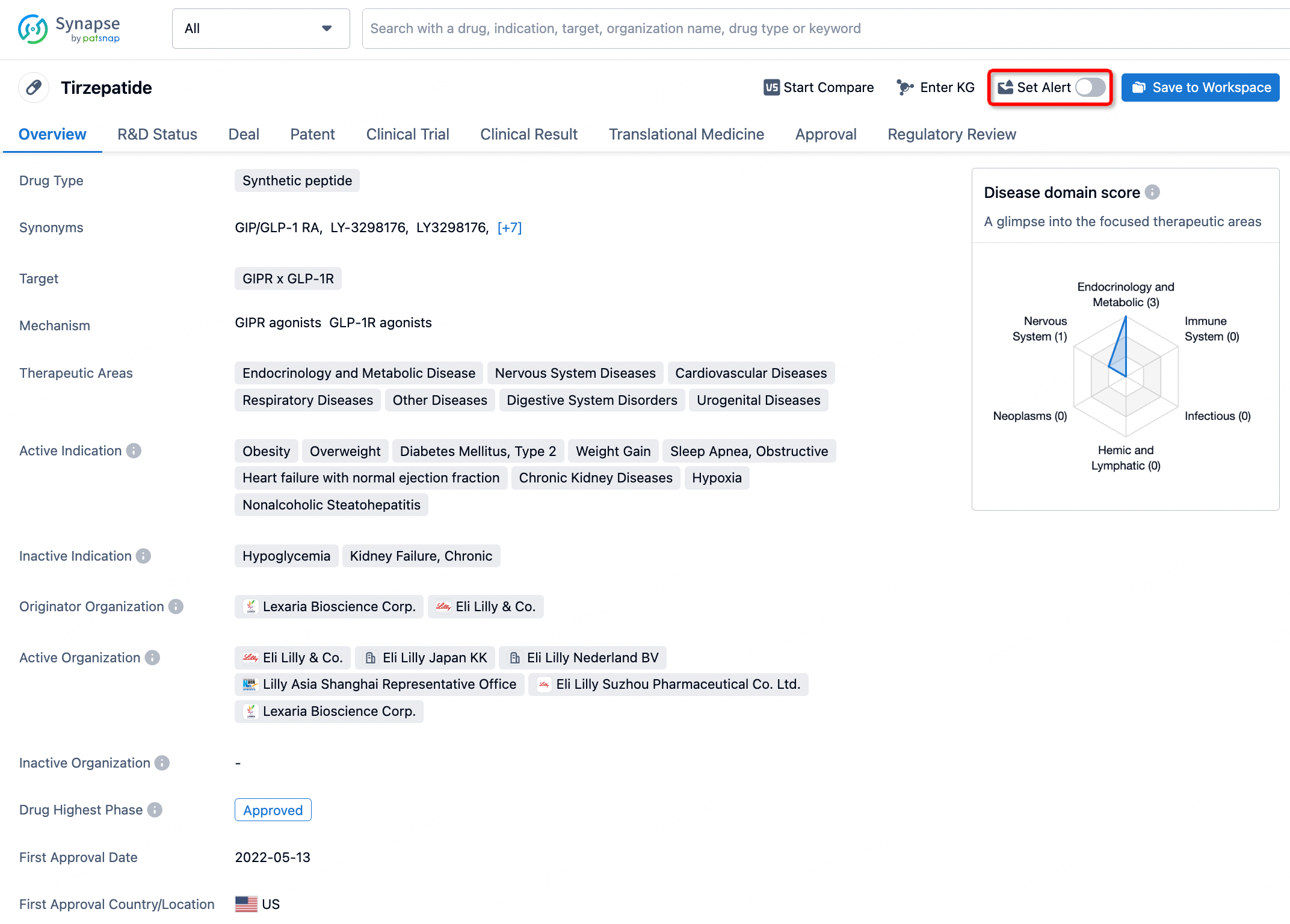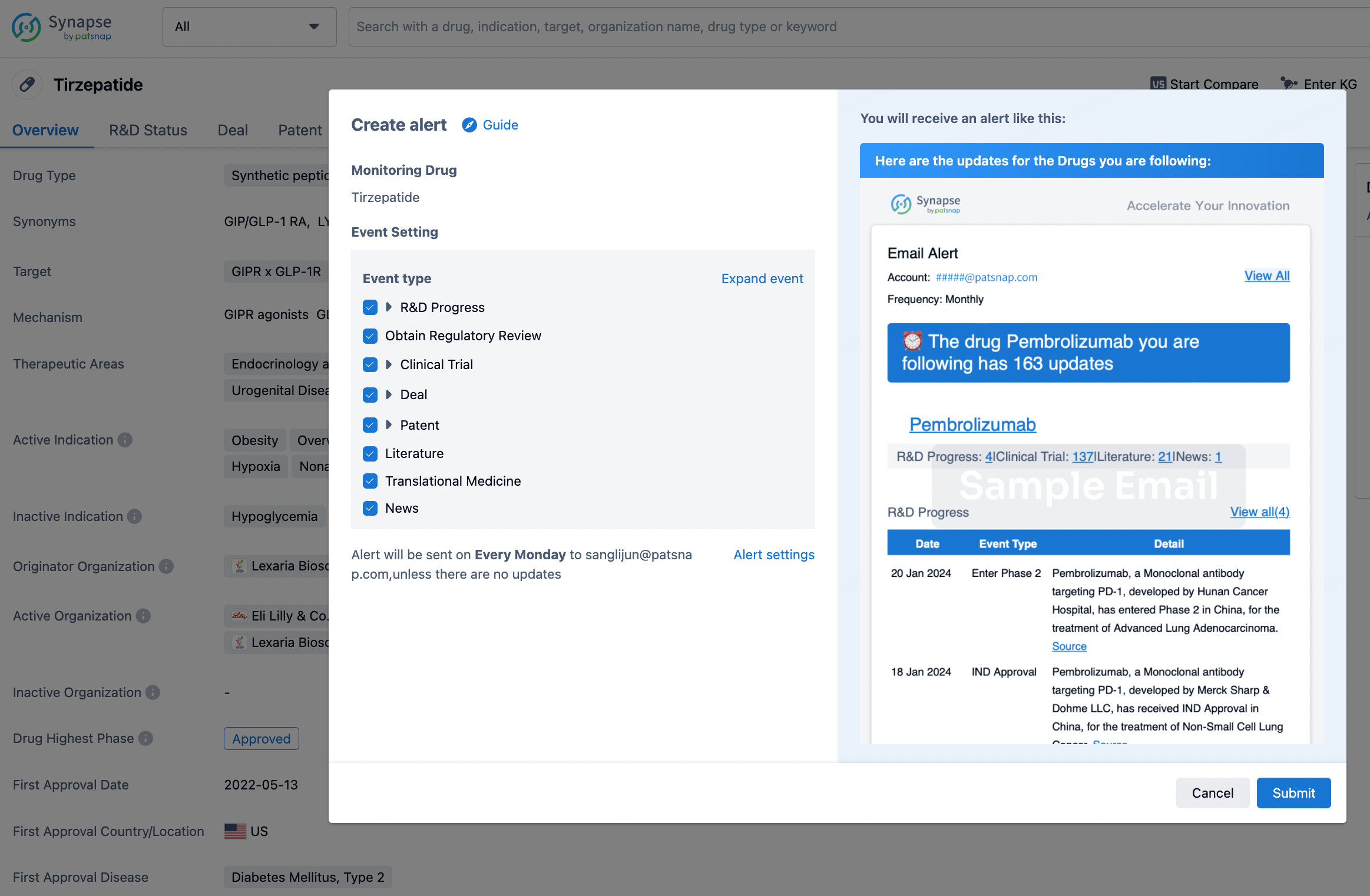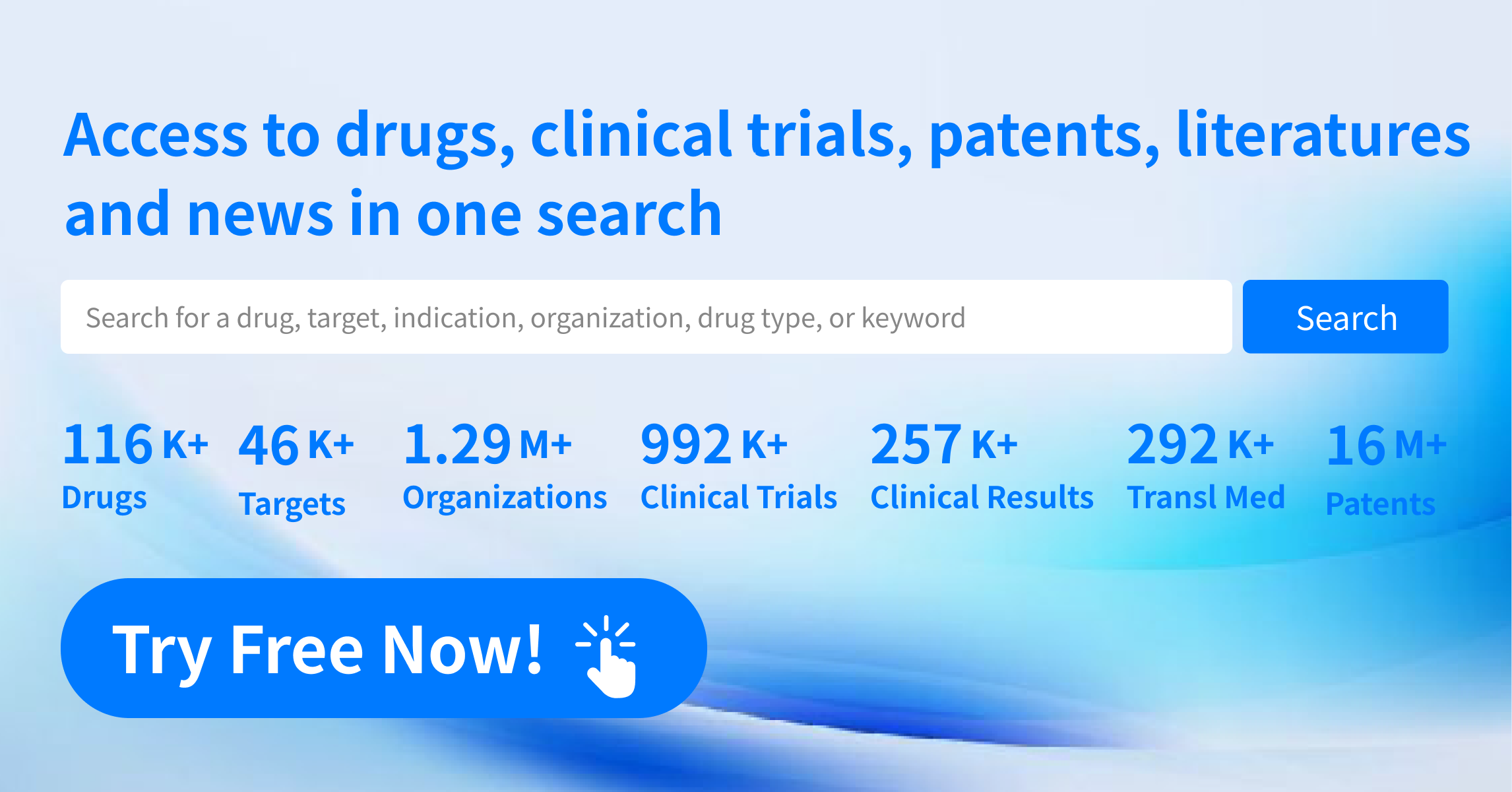Request Demo
What is Dinutuximab beta used for?
14 June 2024
Introduction to Dinutuximab beta:
Dinutuximab beta, also known by the trade names Qarziba and Isqette, is a monoclonal antibody primarily targeting the GD2 ganglioside, a glycolipid found on the surface of certain cancer cells. This drug has emerged as a promising therapeutic option for high-risk neuroblastoma, a rare but aggressive pediatric cancer originating from neural crest cells. The development of Dinutuximab beta has been driven by various research institutions and pharmaceutical companies, including United Therapeutics and Apeiron Biologics. Besides neuroblastoma, ongoing research is exploring its potential in treating other GD2-expressing tumors. As a biologic drug, Dinutuximab beta belongs to the class of immunotherapies, harnessing the body's immune system to identify and attack cancer cells. The drug has undergone extensive clinical trials, demonstrating efficacy and safety, and has received approval from regulatory bodies such as the European Medicines Agency (EMA) for use in specific pediatric oncology settings.
Dinutuximab beta Mechanism of Action:
The mechanism of action of Dinutuximab beta centers around its ability to target and bind to the GD2 ganglioside, which is abundantly expressed on the surface of neuroblastoma cells and other tumors of neuroectodermal origin. Upon binding to GD2, Dinutuximab beta initiates a series of immune system responses that ultimately lead to the destruction of the cancer cells. One of the key processes involved is antibody-dependent cell-mediated cytotoxicity (ADCC). Here, the Fc region of the antibody recruits and activates immune effector cells, such as natural killer (NK) cells and macrophages, which then attack and kill the GD2-expressing cancer cells. Another crucial mechanism is complement-dependent cytotoxicity (CDC). Dinutuximab beta binding activates the complement cascade, a series of protein-driven reactions that result in the formation of membrane attack complexes, leading to the lysis and death of the cancer cells. Moreover, this targeted immunotherapy can enhance the overall immune surveillance, helping in the continuous identification and eradication of residual cancer cells, thus reducing the risk of relapse.
How to Use Dinutuximab beta(Methods of drug administration, onset time, etc.):
Dinutuximab beta is administered intravenously, typically in a clinical setting under the supervision of healthcare professionals experienced in chemotherapy and monoclonal antibody therapy. The standard regimen involves multiple cycles of treatment, with each cycle spanning several days. Before initiating the treatment, patients are usually pre-medicated with analgesics, antihistamines, and antipyretics to mitigate potential infusion-related reactions and pain. The drug is infused over a period of several hours to ensure gradual administration and reduce the risk of adverse effects. The onset of action can vary among patients, but therapeutic effects are generally observed within the first few cycles of treatment. Continuous monitoring and supportive care are essential throughout the treatment period to manage any side effects and assess the patient's response to the therapy. Regular follow-up evaluations, including imaging studies and laboratory tests, are conducted to evaluate the efficacy of the treatment and make necessary adjustments.
What is Dinutuximab beta Side Effects(Drug side effects, contraindications for use, etc.):
Despite its therapeutic benefits, Dinutuximab beta is associated with a range of side effects, some of which can be severe. Commonly reported side effects include pain, particularly neuropathic pain, which is often managed with analgesics such as opioids. Infusion-related reactions, such as fever, chills, and hypotension, are also frequent and can usually be controlled with pre-medication and dose adjustments. Other side effects include capillary leak syndrome, characterized by hypotension, edema, and hypoalbuminemia, and can be life-threatening if not promptly addressed. Hematologic abnormalities, such as anemia, thrombocytopenia, and neutropenia, may occur, necessitating regular blood count monitoring and supportive care. Additionally, patients may experience gastrointestinal symptoms, including nausea, vomiting, and diarrhea, which are typically managed with standard antiemetic and antidiarrheal medications. Contraindications for Dinutuximab beta include hypersensitivity to the drug or its components and pre-existing conditions that could be exacerbated by the drug's side effects. Patients with significant cardiovascular or pulmonary disease, as well as those with active infections, should be evaluated carefully before initiating treatment.
What Other Drugs Will Affect Dinutuximab beta:
The efficacy and safety of Dinutuximab beta can be influenced by concomitant use of other medications. Immunosuppressive drugs, such as corticosteroids, may dampen the immune response activated by Dinutuximab beta, potentially reducing its therapeutic effectiveness. Similarly, other monoclonal antibodies or biologic therapies that target the immune system could interfere with its mechanism of action. Drugs that impact the liver or kidney function should be administered with caution, as they could alter the metabolism and clearance of Dinutuximab beta, affecting its plasma levels and toxicity profile. Pain management strategies often involve the use of opioids and non-steroidal anti-inflammatory drugs (NSAIDs), which should be carefully coordinated to avoid adverse interactions and manage side effects effectively. Additionally, patients receiving concurrent chemotherapy may experience compounded hematologic toxicity, necessitating close monitoring and dose adjustments. It is crucial for healthcare providers to conduct a thorough medication review and consider potential drug-drug interactions when planning Dinutuximab beta therapy to ensure optimal patient outcomes and minimize risks.
In summary, Dinutuximab beta represents a significant advancement in the treatment of high-risk neuroblastoma, offering hope to patients with limited therapeutic options. Its targeted mechanism of action and integration into multi-modal treatment regimens underscore the progress in pediatric oncology. However, careful management of side effects and potential drug interactions is essential to maximize its benefits and ensure patient safety. Ongoing research and clinical experience will continue to refine its use and expand its indications, potentially benefiting a broader range of patients in the future.
Dinutuximab beta, also known by the trade names Qarziba and Isqette, is a monoclonal antibody primarily targeting the GD2 ganglioside, a glycolipid found on the surface of certain cancer cells. This drug has emerged as a promising therapeutic option for high-risk neuroblastoma, a rare but aggressive pediatric cancer originating from neural crest cells. The development of Dinutuximab beta has been driven by various research institutions and pharmaceutical companies, including United Therapeutics and Apeiron Biologics. Besides neuroblastoma, ongoing research is exploring its potential in treating other GD2-expressing tumors. As a biologic drug, Dinutuximab beta belongs to the class of immunotherapies, harnessing the body's immune system to identify and attack cancer cells. The drug has undergone extensive clinical trials, demonstrating efficacy and safety, and has received approval from regulatory bodies such as the European Medicines Agency (EMA) for use in specific pediatric oncology settings.
Dinutuximab beta Mechanism of Action:
The mechanism of action of Dinutuximab beta centers around its ability to target and bind to the GD2 ganglioside, which is abundantly expressed on the surface of neuroblastoma cells and other tumors of neuroectodermal origin. Upon binding to GD2, Dinutuximab beta initiates a series of immune system responses that ultimately lead to the destruction of the cancer cells. One of the key processes involved is antibody-dependent cell-mediated cytotoxicity (ADCC). Here, the Fc region of the antibody recruits and activates immune effector cells, such as natural killer (NK) cells and macrophages, which then attack and kill the GD2-expressing cancer cells. Another crucial mechanism is complement-dependent cytotoxicity (CDC). Dinutuximab beta binding activates the complement cascade, a series of protein-driven reactions that result in the formation of membrane attack complexes, leading to the lysis and death of the cancer cells. Moreover, this targeted immunotherapy can enhance the overall immune surveillance, helping in the continuous identification and eradication of residual cancer cells, thus reducing the risk of relapse.
How to Use Dinutuximab beta(Methods of drug administration, onset time, etc.):
Dinutuximab beta is administered intravenously, typically in a clinical setting under the supervision of healthcare professionals experienced in chemotherapy and monoclonal antibody therapy. The standard regimen involves multiple cycles of treatment, with each cycle spanning several days. Before initiating the treatment, patients are usually pre-medicated with analgesics, antihistamines, and antipyretics to mitigate potential infusion-related reactions and pain. The drug is infused over a period of several hours to ensure gradual administration and reduce the risk of adverse effects. The onset of action can vary among patients, but therapeutic effects are generally observed within the first few cycles of treatment. Continuous monitoring and supportive care are essential throughout the treatment period to manage any side effects and assess the patient's response to the therapy. Regular follow-up evaluations, including imaging studies and laboratory tests, are conducted to evaluate the efficacy of the treatment and make necessary adjustments.
What is Dinutuximab beta Side Effects(Drug side effects, contraindications for use, etc.):
Despite its therapeutic benefits, Dinutuximab beta is associated with a range of side effects, some of which can be severe. Commonly reported side effects include pain, particularly neuropathic pain, which is often managed with analgesics such as opioids. Infusion-related reactions, such as fever, chills, and hypotension, are also frequent and can usually be controlled with pre-medication and dose adjustments. Other side effects include capillary leak syndrome, characterized by hypotension, edema, and hypoalbuminemia, and can be life-threatening if not promptly addressed. Hematologic abnormalities, such as anemia, thrombocytopenia, and neutropenia, may occur, necessitating regular blood count monitoring and supportive care. Additionally, patients may experience gastrointestinal symptoms, including nausea, vomiting, and diarrhea, which are typically managed with standard antiemetic and antidiarrheal medications. Contraindications for Dinutuximab beta include hypersensitivity to the drug or its components and pre-existing conditions that could be exacerbated by the drug's side effects. Patients with significant cardiovascular or pulmonary disease, as well as those with active infections, should be evaluated carefully before initiating treatment.
What Other Drugs Will Affect Dinutuximab beta:
The efficacy and safety of Dinutuximab beta can be influenced by concomitant use of other medications. Immunosuppressive drugs, such as corticosteroids, may dampen the immune response activated by Dinutuximab beta, potentially reducing its therapeutic effectiveness. Similarly, other monoclonal antibodies or biologic therapies that target the immune system could interfere with its mechanism of action. Drugs that impact the liver or kidney function should be administered with caution, as they could alter the metabolism and clearance of Dinutuximab beta, affecting its plasma levels and toxicity profile. Pain management strategies often involve the use of opioids and non-steroidal anti-inflammatory drugs (NSAIDs), which should be carefully coordinated to avoid adverse interactions and manage side effects effectively. Additionally, patients receiving concurrent chemotherapy may experience compounded hematologic toxicity, necessitating close monitoring and dose adjustments. It is crucial for healthcare providers to conduct a thorough medication review and consider potential drug-drug interactions when planning Dinutuximab beta therapy to ensure optimal patient outcomes and minimize risks.
In summary, Dinutuximab beta represents a significant advancement in the treatment of high-risk neuroblastoma, offering hope to patients with limited therapeutic options. Its targeted mechanism of action and integration into multi-modal treatment regimens underscore the progress in pediatric oncology. However, careful management of side effects and potential drug interactions is essential to maximize its benefits and ensure patient safety. Ongoing research and clinical experience will continue to refine its use and expand its indications, potentially benefiting a broader range of patients in the future.
How to obtain the latest development progress of all drugs?
In the Synapse database, you can stay updated on the latest research and development advances of all drugs. This service is accessible anytime and anywhere, with updates available daily or weekly. Use the "Set Alert" function to stay informed. Click on the image below to embark on a brand new journey of drug discovery!
AI Agents Built for Biopharma Breakthroughs
Accelerate discovery. Empower decisions. Transform outcomes.
Get started for free today!
Accelerate Strategic R&D decision making with Synapse, PatSnap’s AI-powered Connected Innovation Intelligence Platform Built for Life Sciences Professionals.
Start your data trial now!
Synapse data is also accessible to external entities via APIs or data packages. Empower better decisions with the latest in pharmaceutical intelligence.


